NDVI-Based Greening of Alpine Steppe and Its Relationships with Climatic Change and Grazing Intensity in the Southwestern Tibetan Plateau
Abstract
:1. Introduction
2. Materials and Methods
2.1. Case Study Area
2.2. Data
2.3. Methods
2.3.1. Linear Trend Analysis Method
2.3.2. Correlation Analysis Method
2.3.3. Residuals Analysis
2.3.4. Calculation of Grazing Intensity
3. Results
3.1. Spatial Distribution Characteristics of NDVI in the SWTP
3.2. Temporal and Spatial Distribution Characteristics of NDVI in the SWTP
3.2.1. Temporal Variation of NDVI
3.2.2. Spatial Variation of the NDVI
3.3. Relationships between the Vegetation Dynamics and Climate Factors
3.4. Relationships between Vegetation Dynamics and Human Activities
3.5. Relationships between the Vegetation Dynamics and Grazing Intensity
4. Discussion
4.1. Spatiotemporal Change Characteristics of NDVI in the SWTP in the Last Two Decades
4.2. Effects of Temperature and Precipitation on the NDVI in the Growing Season
4.3. Effects of Human Activities on the NDVI in the Growing Season
4.4. Effects of Grazing Intensity on the NDVI in the Growing Season
4.5. Limitations and Outlook
5. Conclusions
Author Contributions
Funding
Data Availability Statement
Conflicts of Interest
References
- Li, J.J.; Peng, S.Z.; Li, Z. Detecting and attributing vegetation changes on China’s Loess Plateau. Agric. For. Meteorol. 2017, 247, 260–270. [Google Scholar] [CrossRef]
- Lou, J.P.; Xu, G.Y.; Wang, Z.J.; Yang, Z.G.; Ni, S.C. Multi-year NDVI values as indicator of the relationship between spatiotemporal vegetation dynamics and environmental factors in the Qaidam Basin, China. Remote Sens. 2021, 13, 1240. [Google Scholar] [CrossRef]
- Parmesan, C.; Yohe, G. A globally coherent fingerprint of climate change impacts across natural systems. Nature 2003, 421, 37–42. [Google Scholar] [CrossRef] [PubMed]
- Wang, X.L.; Zhang, G.H. Vegetation pattern formation in seminal systems due to internal competition reaction between plants. J. Theor. Biol. 2018, 458, 10–14. [Google Scholar] [CrossRef] [PubMed]
- Zhang, X.L.; Huang, X.R. Human disturbance caused stronger influences on global vegetation change than climate change. PeerJ 2019, 25, e7763. [Google Scholar] [CrossRef]
- Hao, L.; Pan, C.; Fang, D.; Zhang, X.Y.; Zhou, D.C.; Liu, P.L.; Liu, Y.Q.; Sun, G. Quantifying the effects of overgrazing on mountainous watershed vegetation dynamics under a changing climate. Sci. Total Environ. 2018, 639, 1408–1420. [Google Scholar] [CrossRef]
- Adepoju, K.; Adelabu, S.; Fashae, O. Vegetation response to recent trends in climate and land-use dynamics in a typical humid and dry tropical region under Global Change. Adv. Meteorol. 2019, 2019, 1–15. [Google Scholar] [CrossRef] [Green Version]
- Wang, Y.; Peng, D.L.; Shen, M.G.; Xu, X.Y.; Yang, X.H.; Huang, W.J.; Yu, L.; Liu, L.Y.; Li, X.W.; Zheng, S.J.; et al. Contrasting effects of temperature and precipitation on vegetation greenness along elevation gradients of the Tibetan Plateau. Remote Sens. 2020, 12, 2751. [Google Scholar] [CrossRef]
- Li, D.; Luo, H.Y.; Hu, T.S.; Shao, D.G.; Cui, Y.L.; Khan, S.; Luo, Y.F. Identification of the roles of climate factors; engineering construction; and agricultural practices in vegetation dynamics in the Lhasa River Basin, Tibetan Plateau. Remote Sens. 2020, 12, 1883. [Google Scholar] [CrossRef]
- Pang, G.J.; Wang, X.J.; Yang, M.X. Using the NDVI to identify variations in and responses of vegetation to climate change on the Tibetan Plateau from 1982 to 2012. Quat. Int. 2017, 444, 87–96. [Google Scholar] [CrossRef]
- Moradi, H.; Attar, F.; Oldeland, J. Plant functional type approach for a functional interpretation of altitudinal vegetation zones in the Alborz Mts., Iran. J. Mt. Sci. 2017, 14, 2257–2269. [Google Scholar] [CrossRef]
- Wan, Z.J.; Wang, C.J.; Qu, H.; Liu, R.; Zhang, X.Z. Vulnerability of forest vegetation to anthropogenic climate change in China. Sci. Total Environ. 2018, 621, 1633–1641. [Google Scholar] [CrossRef]
- John, R.; Chen, J.Q.; Kim, Y.W.; Ou-yang, Z.T.; Xiao, J.F.; Park, H.Q.; Shao, C.L.; Zhang, Y.Q.; Amarjargal, A.; Batkhshig, C. Differentiating anthropogenic modification and precipitation-driven change on vegetation productivity on the Mongolian Plateau. Landsc. Ecol. 2016, 31, 547–566. [Google Scholar] [CrossRef]
- Sun, W.C.; Wang, Y.Y.; Fu, Y.S.; Xue, B.L.; Wang, G.Q.; Yu, J.S.; Zuo, D.P.; Xu, Z.X. Spatial heterogeneity of changes in vegetation growth and their driving forces based on satellite observations of the Yarlung Zangbo River Basin in the Tibetan Plateau. J. Hydrol. 2019, 574, 324–332. [Google Scholar] [CrossRef]
- Li, S.S.; Yang, S.N.; Liu, X.F.; Liu, Y.X.; Shi, M.M. NDVI-Based analysis on the influence of climate change and human activities on vegetation restoration in the Shaanxi-Gansu-Ningxia region; Central China. Remote Sens. 2015, 7, 11163–11182. [Google Scholar] [CrossRef] [Green Version]
- Yang, J.; Wan, Z.Q.; Borjign, S.; Zhang, D.; Yan, Y.L.; Chen, Y.L.; Gu, R.; Gao, Q.Z. Changing trends of NDVI and their responses to climatic variation in different types of grassland in Inner Mongolia from 1982 to 2011. Sustainability 2019, 11, 3256. [Google Scholar] [CrossRef] [Green Version]
- Wang, J.; Meng, J.J.; Cai, Y.L. Assessing vegetation dynamics impacted by climate change in the southwestern karst region of China with AVHRR NDVI and AVHRR NPP time-series. Environ. Geol. 2008, 54, 1185–1195. [Google Scholar] [CrossRef]
- Mao, D.H.; Wang, Z.M.; Luo, L.; Ren, C.Y. Integrating AVHRR and MODIS data to monitor NDVI changes and their relationships with climatic parameters in Northeast China. Int. J. Appl. Earth Obs. Geoinf. 2012, 18, 528–536. [Google Scholar] [CrossRef]
- Sun, Y.L.; Yang, Y.L.; Zhang, Y.; Wang, Z.L. Assessing vegetation dynamics and their relationships with climatic variability in northern China. Phys. Chem. Earth 2015, 87, 79–86. [Google Scholar] [CrossRef]
- Pan, N.Q.; Feng, X.M.; Fu, B.J.; Wang, S.; Ji, F.; Pan, S.F. Increasing global vegetation browning hidden in overall vegetation greening: Insights from time- varying trends. Remote Sens. Environ. 2018, 214, 59–72. [Google Scholar] [CrossRef]
- Wang, L.; Qiu, Y.N.; Han, Z.Y.; Xu, C.; Wu, S.Y.; Wang, Y.; Holmgren, M.; Xu, Z.W. Climate; topography and anthropogenic effects on desert greening: A 40-year satellite monitoring in the Tengger Desert, northern China. Catena 2022, 209, 105851. [Google Scholar] [CrossRef]
- Ding, M.J.; Zhang, Y.L.; Liu, L.S.; Zhang, W.; Wang, Z.F.; Bai, W.Q. The relationship between NDVI and precipitation on the Tibetan Plateau. J. Geog. Sci. 2007, 17, 259–268. [Google Scholar] [CrossRef]
- Chen, J.H.; Yan, F.; Lu, Q. Spatiotemporal variation of vegetation on the Qinghai-Tibet Plateau and the influence of climatic factors and human activities on vegetation trend (2000–2019). Remote Sens. 2020, 12, 3150. [Google Scholar] [CrossRef]
- Zhong, L.; Ma, Y.M.; Salama, S.; Su, Z.B. Assessment of vegetation dynamics and their response to variations in precipitation and temperature in the Tibetan Plateau. Clim. Change 2010, 103, 519–535. [Google Scholar] [CrossRef]
- Shrestha, U.B.; Gautam, S.; Bawa, S.K. Widespread climate change in the Himalayas and associated changes in local ecosystems. PLoS ONE 2012, 7, 36741. [Google Scholar] [CrossRef] [Green Version]
- Piao, S.L.; Cui, M.D.; Chen, A.P.; Wang, X.H.; Ciais, P.; Liu, J.; Tang, Y.H. Altitude and temperature dependence of change in the spring vegetation green-up date from 1982 to 2006 in the Qinghai-Xizang Plateau. Agric. For. Meteorol. 2011, 151, 1599–1608. [Google Scholar] [CrossRef]
- Liu, X.F.; Zhang, J.S.; Zhu, X.F.; Pan, Y.Z.; Liu, Y.X.; Zhang, D.H.; Lin, Z.H. Spatiotemporal changes in vegetation cover and its driving factors in the Three-River Headwaters Region during 2000–2011. J. Geogr. Sci. 2014, 24, 288–302. [Google Scholar] [CrossRef]
- Hua, T.; Wang, X.M. Temporal and spatial variations in the climate controls of vegetation dynamics on the Tibetan Plateau during 1982–2011. Adv. Atmos. Sci. 2018, 35, 1337–1346. [Google Scholar] [CrossRef]
- Fassnacht, F.E.; Schiller, C.; Kattenborn, T.; Zhao, X.Q.; Qu, J.P. A Landsat-based vegetation trend product of the Tibetan Plateau for the time-period 1990–2018. Sci. Data 2019, 6, 78. [Google Scholar] [CrossRef]
- Sun, J.; Qin, X.J. Precipitation and temperature regulate the seasonal changes of NDVI across the Tibetan Plateau. Environ. Earth Sci. 2016, 75, 291. [Google Scholar] [CrossRef]
- Jiang, Y.; Wang, P.; Xu, X.D.; Zhang, J.H. Dynamics of carbon fluxes with responses to vegetation, meteorological and terrain factors in the south-eastern Tibetan Plateau. Environ. Earth Sci. 2014, 72, 4551–4565. [Google Scholar] [CrossRef]
- Liu, L.B.; Wang, Y.; Wang, Z.; Li, D.L.; Zhang, Y.T.; Qin, D.H.; Li, S.C. Elevation-dependent decline in vegetation greening rate driven by increasing dryness based on three satellite NDVI datasets on the Tibetan Plateau. Ecol. Indic. 2019, 107, 105569. [Google Scholar] [CrossRef]
- Peng, D.L.; Zhou, B.; Li, C.J.; Huang, W.J.; Wu, Y.P.; Yang, X.H. Phenological characteristics of the main vegetation types on the Tibetan Plateau based on vegetation and water indices. IOP Conf. Ser. Earth Environ. Sci. 2014, 17, 012077. [Google Scholar] [CrossRef] [Green Version]
- Duan, H.C.; Xue, X.; Wang, T.; Kang, W.P.; Liao, J.; Liu, S.L. Spatial and temporal differences in alpine meadow, alpine steppe and all vegetation of the Qinghai-Tibetan Plateau and their responses to Climate Change. Remote Sens. 2021, 13, 669. [Google Scholar] [CrossRef]
- Cai, H.Y.; Yang, X.H.; Xu, X.L. Human-induced grassland degradation/restoration in the central Tibetan Plateau: The effects of ecological protection and restoration projects. Ecol. Eng. 2015, 83, 112–119. [Google Scholar] [CrossRef]
- Gillespie, T.W.; Madson, A.; Cusack, C.F.; Xue, Y.K. Changes in NDVI and human population in protected areas on the Tibetan Plateau. Arct. Antarct. Alp. Res. 2019, 51, 428–439. [Google Scholar] [CrossRef] [Green Version]
- Li, L.H.; Zhang, Y.L.; Liu, L.S.; Wu, J.S.; Wang, Z.F.; Li, S.C.; Zhang, H.M.; Zu, J.X.; Ding, M.J.; Paudel, B. Spatiotemporal patterns of vegetation greenness change and associated climatic and anthropogenic drivers on the Tibetan Plateau during 2000–2015. Remote Sens. 2018, 10, 1525. [Google Scholar] [CrossRef] [Green Version]
- Bai, Y.F.; Guo, C.C.; Degen, A.; Ahmad, A.A.; Wang, W.Y.; Zhang, T.; Li, W.Y.; Ma, L. Climate warming benefits alpine vegetation growth in Three-River Headwater Region, China. Sci. Total Environ. 2020, 742, 140574. [Google Scholar] [CrossRef]
- Li, P.L.; Hu, Z.M.; Liu, Y.W. Shift in the trend of browning in Southwestern Tibetan plateau in the past two decades. Agric. For. Meteorol. 2020, 287, 107950. [Google Scholar] [CrossRef]
- Ran, Q.W.; Hao, Y.B.; Xia, A.Q.; Liu, W.J.; Hu, R.H.; Cui, X.Y.; Xue, K.; Song, X.N.; Xu, C.; Ding, B.Y.; et al. Quantitative assessment of the impact of physical and anthropogenic factors on vegetation spatial-temporal variation in Northern Tibet. Remote Sens. 2019, 11, 1183. [Google Scholar] [CrossRef] [Green Version]
- Cao, J.; Adamowski, J.F.; Deo, R.C.; Xu, X.; Gong, Y.; Feng, Q. Grassland degradation on the Qinghai-Tibetan plateau: Reevaluation of causative factors. Rangel. Ecol. Manag. 2019, 72, 988–995. [Google Scholar] [CrossRef]
- Fang, Y.P.; Qin, D.H.; Ding, Y.J.; Yang, J.P.; Xu, K.Y. The impacts of permafrost change on NPP and implications: A case of the source regions of Yangtze and Yellow Rivers. J. Mt. Sci. 2011, 8, 437–447. [Google Scholar] [CrossRef]
- Guo, N.; Li, Y.H.; Han, L.Y.; Yang, S.P. The effects of climate change on different types of grassland in Maqu county in northeast Tibetan Plateau. In Proceedings of the 2012 IEEE International Geoscience and Remote Sensing Symposium, Munich, Germany, 22 July 2012; pp. 1139–1142. [Google Scholar] [CrossRef]
- Li, C.J.; Fu, B.J.; Wang, S.; Stringer, L.C.; Wang, Y.P.; Li, Z.D.; Liu, Y.X.; Zhou, W.X. Drivers and impacts of changes in China’s drylands. Nat. Rev. Earth Environ. 2021, 2, 858–873. [Google Scholar] [CrossRef]
- Sun, J.; Liu, M.; Fu, B.J.; Kemp, D.; Zhao, W.W.; Liu, G.H.; Han, G.D.; Wilkes, A.; Lu, X.Y.; Chen, C.Y.; et al. Reconsidering the efficiency of grazing exclusion using fences on the Tibetan Plateau. Sci. Bull. 2020, 65, 1405–1414. [Google Scholar] [CrossRef]
- Sun, J.; Fu, B.J.; Zhao, W.W.; Liu, L.S.; Liu, G.H.; Zhou, H.K.; Shao, X.Q.; Chen, Y.C.; Zhang, Y.; Deng, Y.F. Optimizing grazing exclusion practices to achieve Goal 15 of the sustainable development goals in the Tibetan Plateau. Sci. Bull. 2021, 66, 1493–1496. [Google Scholar] [CrossRef]
- Li, Y.; Jin, T.T.; Gao, B.L.; Zhang, Y.X.; Gong, J. Spatiotemporal variation of climate and its potential productivity in the SW Tibet Plateau during 1901 to 2017. J. Nat. Resour. 2022, 37, 1–17. [Google Scholar] [CrossRef]
- Sun, H.L.; Zheng, D.; Yao, T.D.; Zhang, Y.L. Protection and construction of the national ecological security shelter zone on Tibetan Plateau. Acta Geogr. Sin. 2012, 67, 3–12. [Google Scholar] [CrossRef]
- Li, Y.; Dai, R.; Zhang, Y.X.; Gong, J. Spatiotemporal variation of vegetation NDVI and its relationship with altitude gradient in Southwest Tibet Plateau. Res. Soil and Water Conserv. 2021, 29, 215–222. [Google Scholar] [CrossRef]
- Hu, Y.F.; Dao, R.N.; Hu, Y. Vegetation change and driving factors: Contribution analysis in the Loess Plateau of China during 2000–2015. Sustainability 2019, 11, 1320. [Google Scholar] [CrossRef] [Green Version]
- Cong, N.; Shen, M.G.; Yang, W.; Yang, Z.Y.; Zhang, G.X.; Piao, S.L. Varying responses of vegetation activity to climate changes on the Tibetan Plateau grassland. Int. J. Biometeorol. 2017, 61, 1433–1444. [Google Scholar] [CrossRef]
- Zhang, Y.; Liang, S.; Xiao, Z. Observed vegetation greening and its relationships with cropland changes and climate in China. Land 2020, 9, 274. [Google Scholar] [CrossRef]
- Peng, S.Z.; Ding, Y.X.; Liu, W.Z.; Li, Z. 1 km monthly temperature and precipitation dataset for China from 1901 to 2017. Earth Syst. Sci. Data 2019, 11, 1931–1946. [Google Scholar] [CrossRef] [Green Version]
- Meng, M.; Huang, N.; Wu, M.Q.; Pei, J.; Wang, J.; Niu, Z. Vegetation change in response to climate factors and human activities on the Mongolian Plateau. PeerJ 2019, 7, e7735. [Google Scholar] [CrossRef] [PubMed]
- He, D.; Huang, X.L.; Tian, Q.J.; Zhang, Z.C. Changes in vegetation growth dynamics and relations with climate in Inner Mongolia under more strict multiple pre-processing (2000-2018). Sustainability 2020, 12, 2534. [Google Scholar] [CrossRef] [Green Version]
- Luo, N.; Mao, D.; Wen, B.; Liu, X. Climate change effected vegetation dynamics in the Northern Xinjiang of China: Evaluation by SPEI and NDVI. Land 2020, 9, 90. [Google Scholar] [CrossRef] [Green Version]
- Zhang, B.; Zhou, W. Spatial-temporal characteristics of precipitation and its relationship with Land Use/Cover Change on the Qinghai-Tibet Plateau, China. Land 2021, 10, 269. [Google Scholar] [CrossRef]
- Duo, W.; Ni, X.N.; Jing, D.Y.; Li, S.H. Spatial-temporal patterns of vegetation dynamics and their relationships to climate variations in Qinghai Lake Basin using MODIS time-series data. J. Geogr. Sci. 2014, 24, 1009–1021. [Google Scholar] [CrossRef]
- Sun, Y.L.; Yang, Y.L.; Zhang, L.; Wang, Z.L. The relative roles of climate variations and human activities in vegetation change in North China. Phys. Chem. Earth 2015, 87, 67–78. [Google Scholar] [CrossRef]
- Li, R.H.; Li, X.B.; Li, G.Q.; Wen, W.Y. Simulation of soil nitrogen storage of the typical steppe with the DNDC model: A case study in Inner Mongolia, China. Ecol. Indic. 2014, 41, 155–164. [Google Scholar] [CrossRef]
- Ji, G.; Song, H.; Wei, H.; Wu, L. Attribution analysis of climate and anthropic factors on runoff and vegetation changes in the Source Area of the Yangtze River from 1982 to 2016. Land 2021, 10, 612. [Google Scholar] [CrossRef]
- Ma, C.H.; Xie, Y.W.; Duan, H.M.; Wang, X.Y.; Bie, Q.; Guo, Z.C.; He, L.; Qin, W.H. Spatial quantification method of grassland utilization intensity on the Qinghai-Tibetan Plateau: A case study on the Selinco basin. J. Environ. Manag. 2022, 302, 114073. [Google Scholar] [CrossRef] [PubMed]
- Yu, L.; Zhou, L.; Liu, W.; Zhou, H.K. Using remote sensing and GIS technologies to estimate grass yield and livestock carrying capacity of alpine grasslands in Golog Prefecture, China. Pedosphere 2010, 20, 342–351. [Google Scholar] [CrossRef]
- Cai, S.H.; Song, X.N.; Hu, R.H.; Guo, D. Ecosystem-dependent responses of vegetation cover on the Tibetan Plateau to climate factors and their lag periods. ISPRS Int. J. Geo-Inf. 2021, 10, 394. [Google Scholar] [CrossRef]
- Zhang, Y.L.; Qi, W.; Zhou, C.P.; Ding, M.J.; Liu, L.S.; Gao, J.G.; Bai, W.Q.; Wang, Z.F.; Zheng, D. Spatial and temporal variability in the net primary production of alpine grassland on the Tibetan Plateau since 1982. J. Geogr. Sci. 2014, 24, 269–287. [Google Scholar] [CrossRef]
- Shen, M.G.; Piao, S.L.; Jeong, S.J.; Zhou, L.M.; Zeng, Z.Z.; Ciais, P.; Chen, D.; Huang, M.; Jin, C.S.; Li, L. Evaporative cooling over the Tibetan plateau induced by vegetation growth. Proc. Natl. Acad. Sci. USA 2015, 112, 9299–9304. [Google Scholar] [CrossRef] [Green Version]
- Ganjurjav, H.; Gao, Q.Z.; Gornish, E.S.; Schwartz, M.W.; Liang, Y.; Cao, X.J.; Zhang, E.N.; Zhang, Y.; Li, W.H.; Wan, Y.F. Differential response of alpine steppe and alpine meadow to climate warming in the central Qinghai-Tibetan Plateau. Agric. For. Meteorol. 2016, 223, 233–240. [Google Scholar] [CrossRef] [Green Version]
- Huang, J.P.; Ji, M.X.; Xie, Y.K.; Wang, S.S.; He, Y.L.; Ran, J.J. Global semi-arid climate change over last 60 years. Clim. Dyn. 2016, 46, 1131–1150. [Google Scholar] [CrossRef] [Green Version]
- Zhang, L.; Guo, H.D.; Ji, L.; Lei, L.P.; Wang, C.Z.; Yan, D.M.; Li, B.; Li, J. Vegetation greenness trend (2000 to 2009) and the climate controls in the Qinghai-Tibetan Plateau. J. Appl. Remote Sens. 2013, 7, 073572. [Google Scholar] [CrossRef]
- Yan, Y.; Lu, X. Is grazing exclusion effective in restoring vegetation in degraded alpine grasslands in Tibet, China? PeerJ 2015, 3, e1020. [Google Scholar] [CrossRef] [Green Version]
- Chen, B.X.; Zhang, X.Z.; Tao, J.; Wu, J.S.; Wang, J.S.; Shi, P.L.; Zhang, Y.J.; Yu, C.Q. The impact of climate change and anthropogenic activities on alpine grassland over the Qinghai-Tibet Plateau. Agric. For. Meteorol. 2014, 189–190, 11–18. [Google Scholar] [CrossRef]
- Xu, Z.R.; Wei, Z.Q.; Jin, M.M. Causes of domestic livestock-wild herbivore conflicts in the alpine ecosystem of the Chang Tang Plateau. Environ. Dev. 2020, 34, 100945. [Google Scholar] [CrossRef]
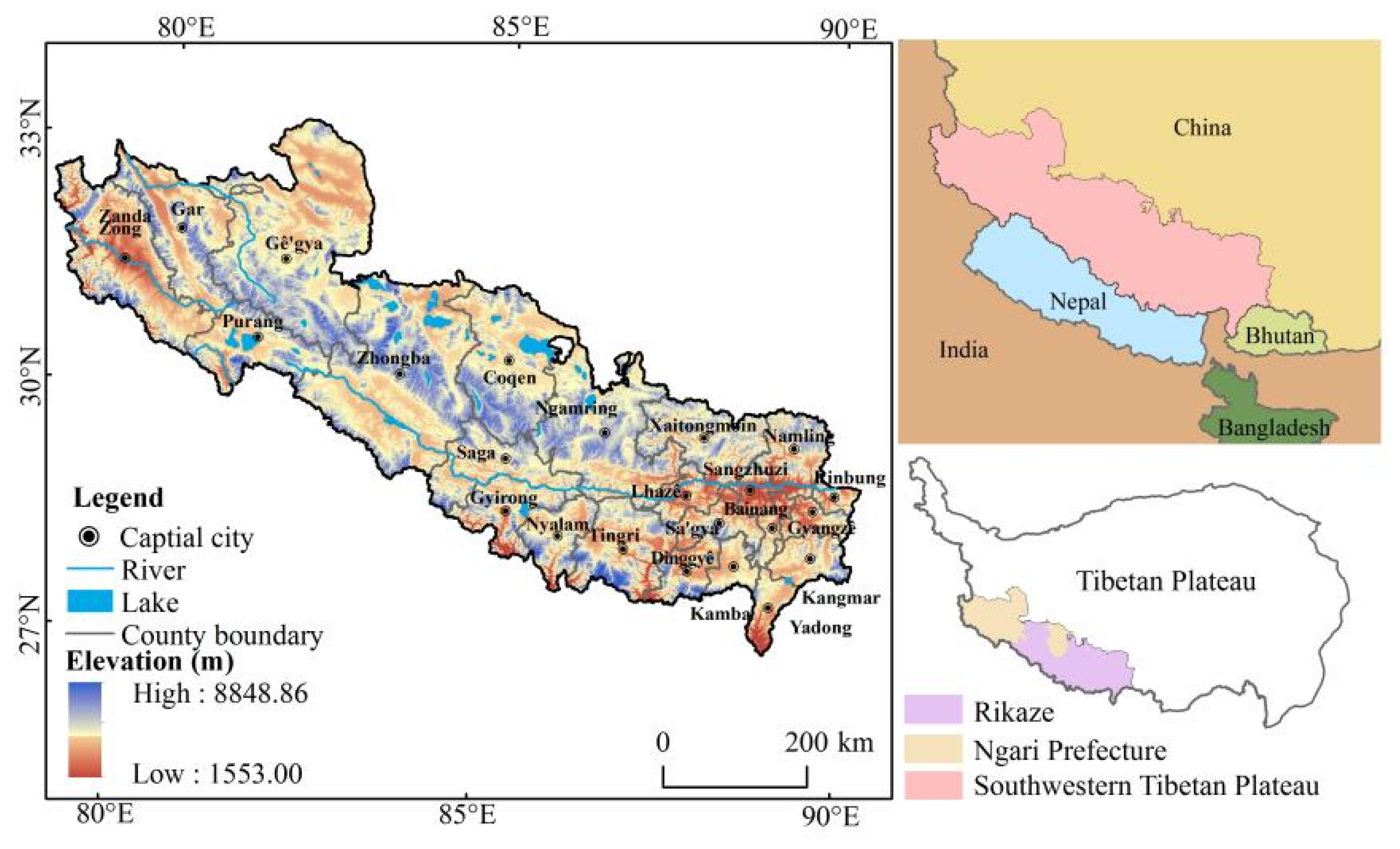

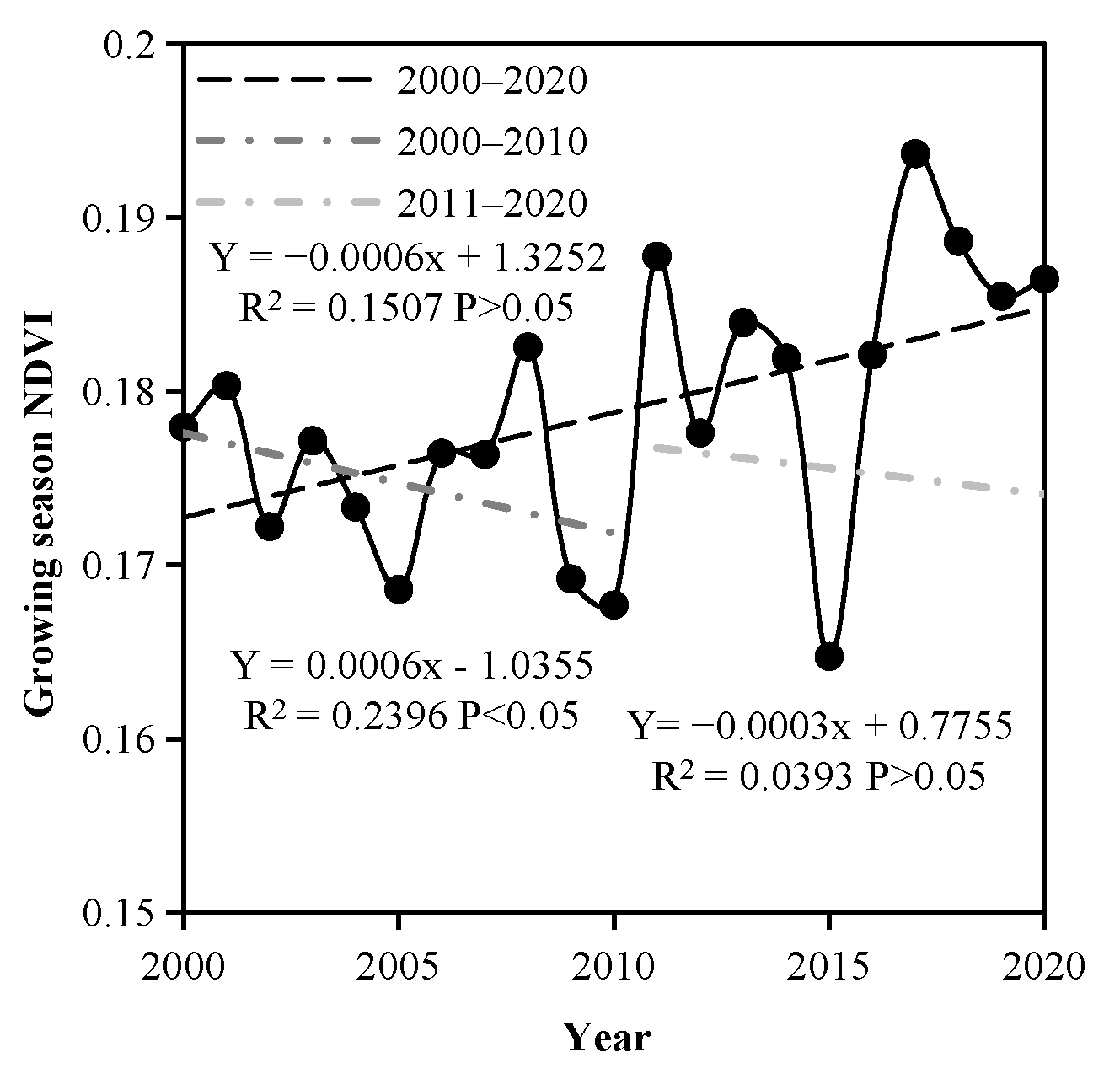
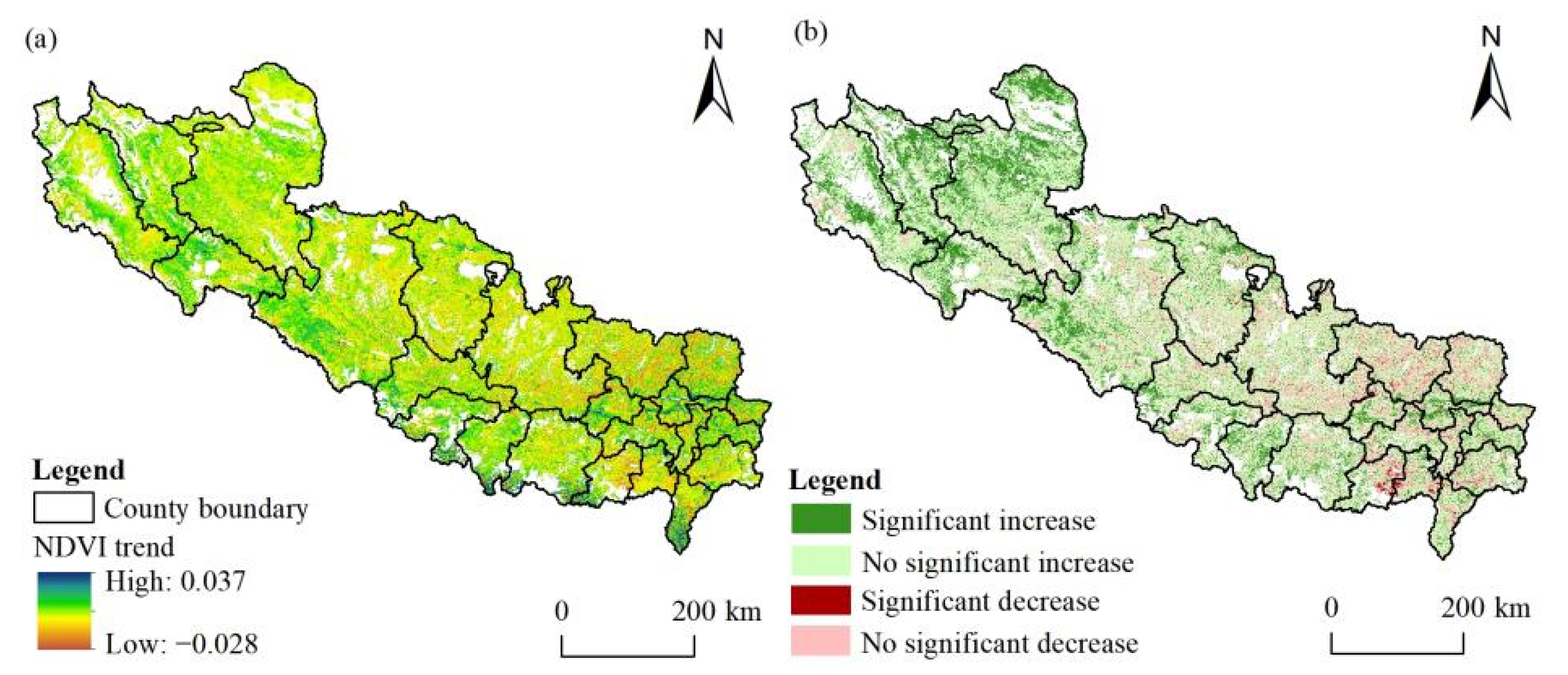
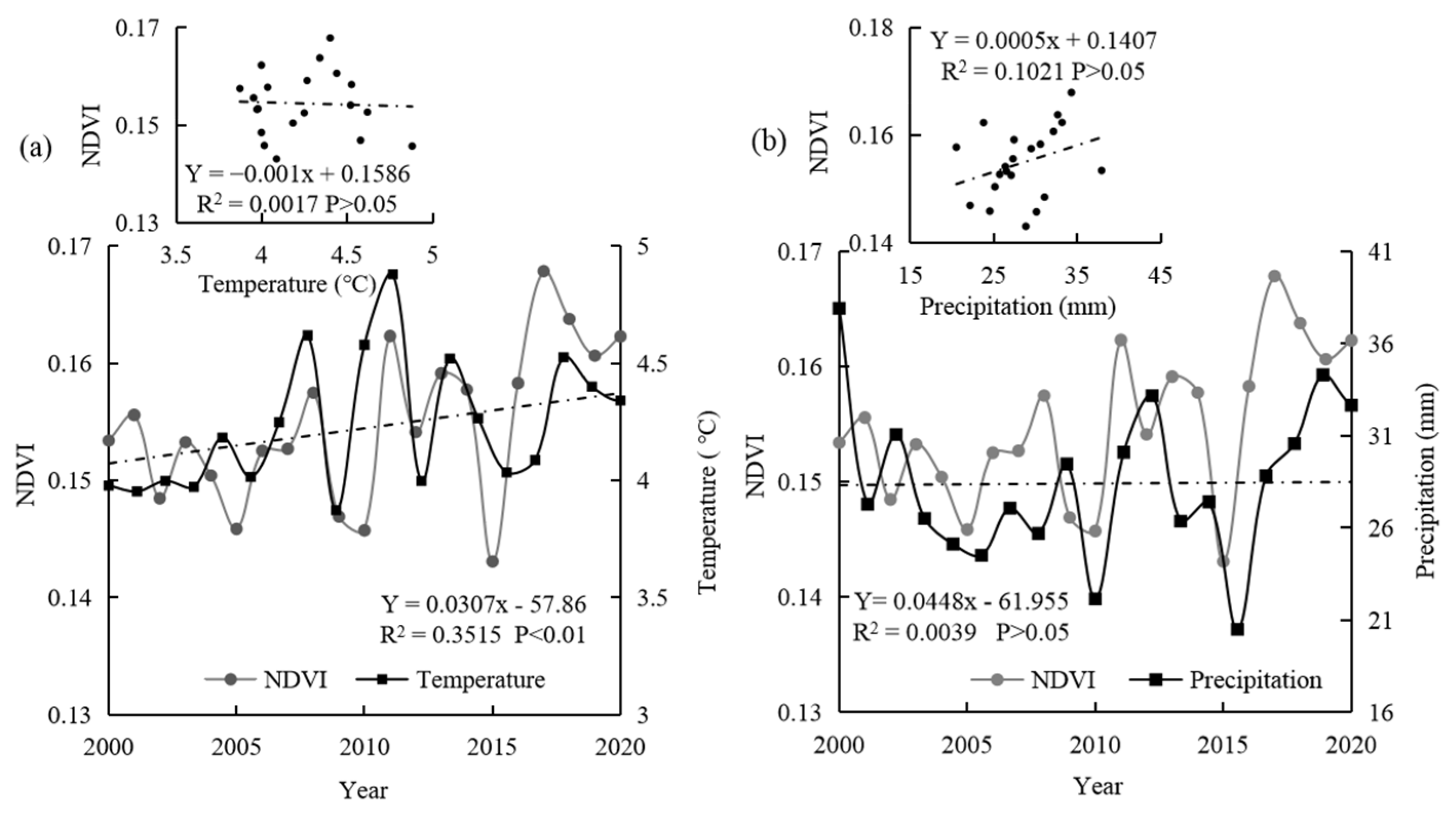
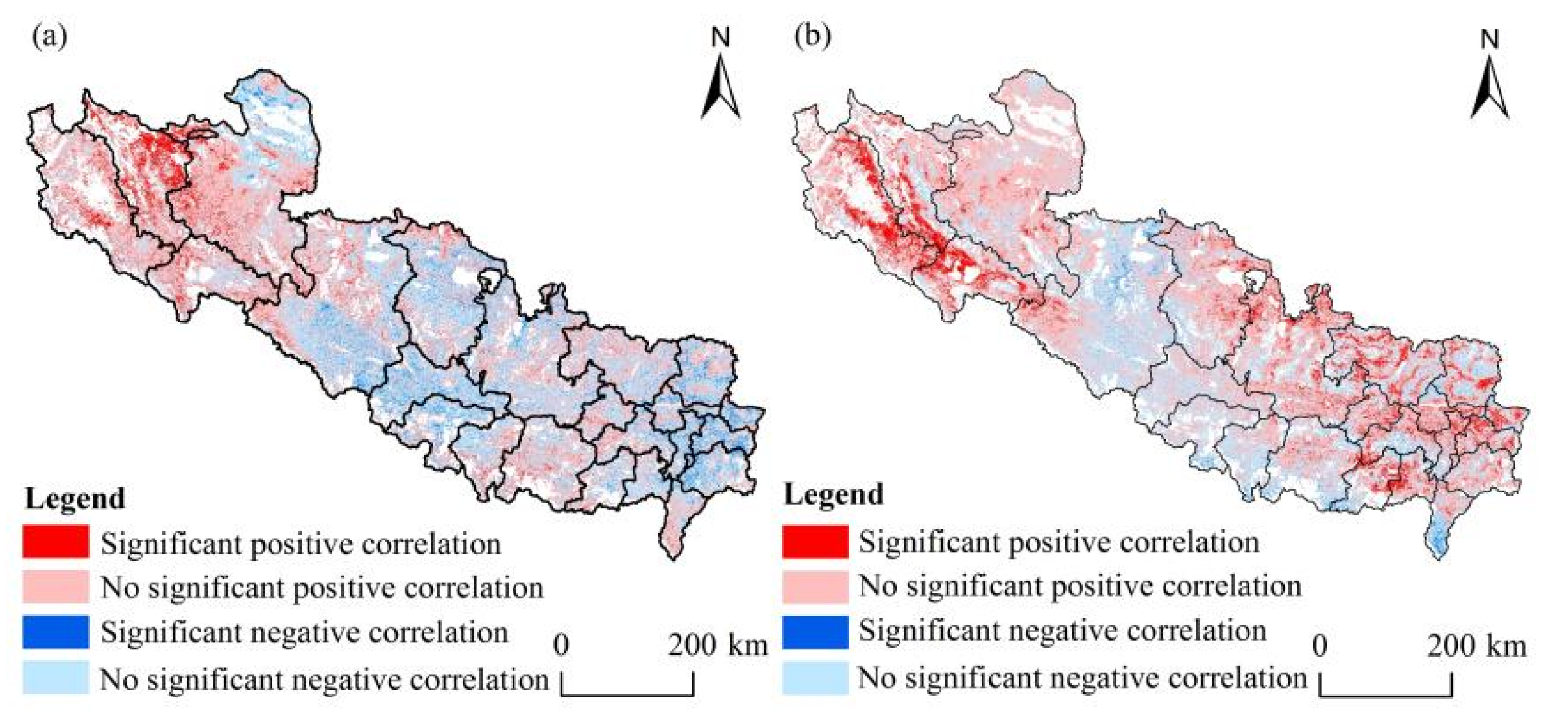

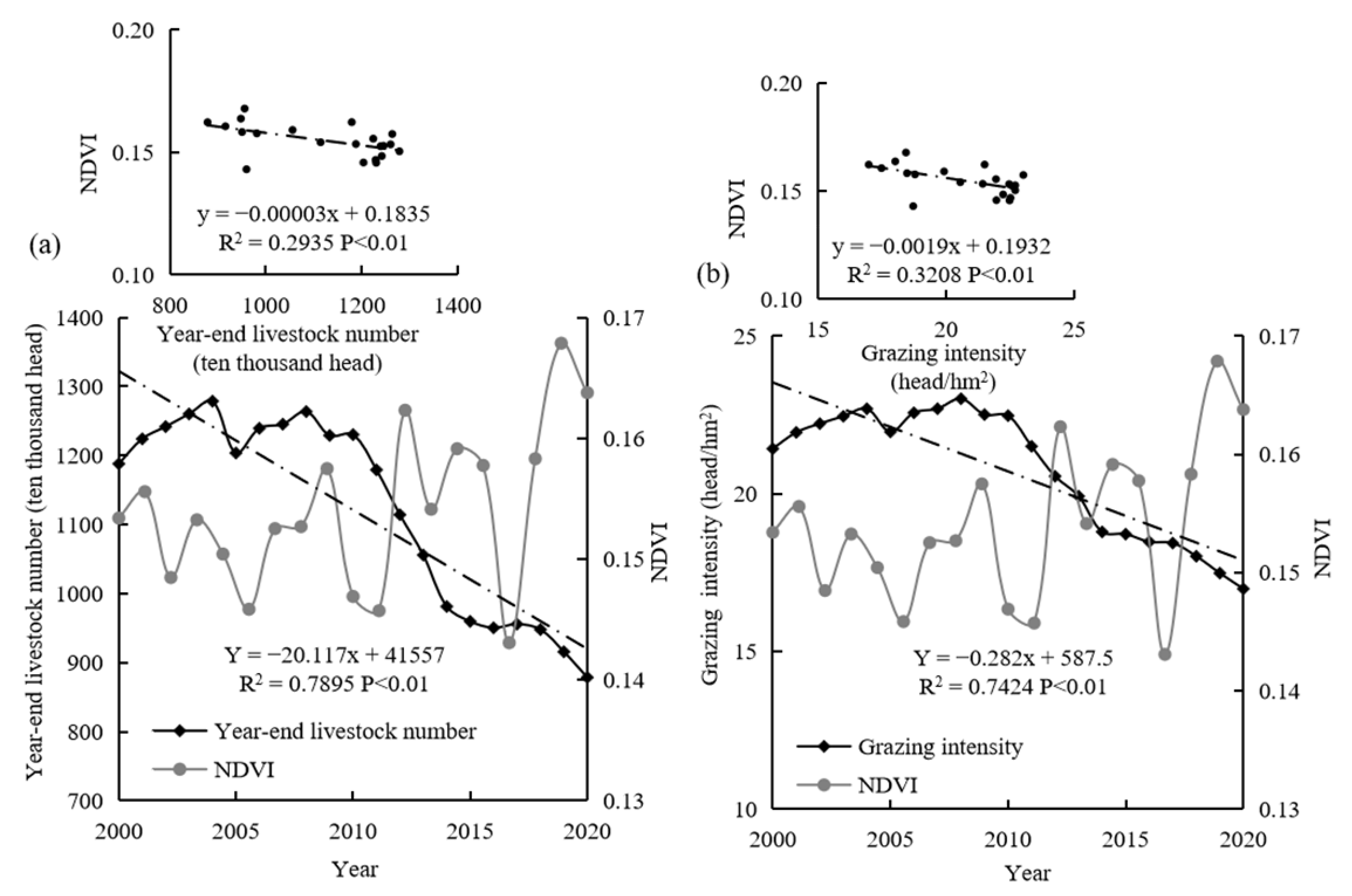
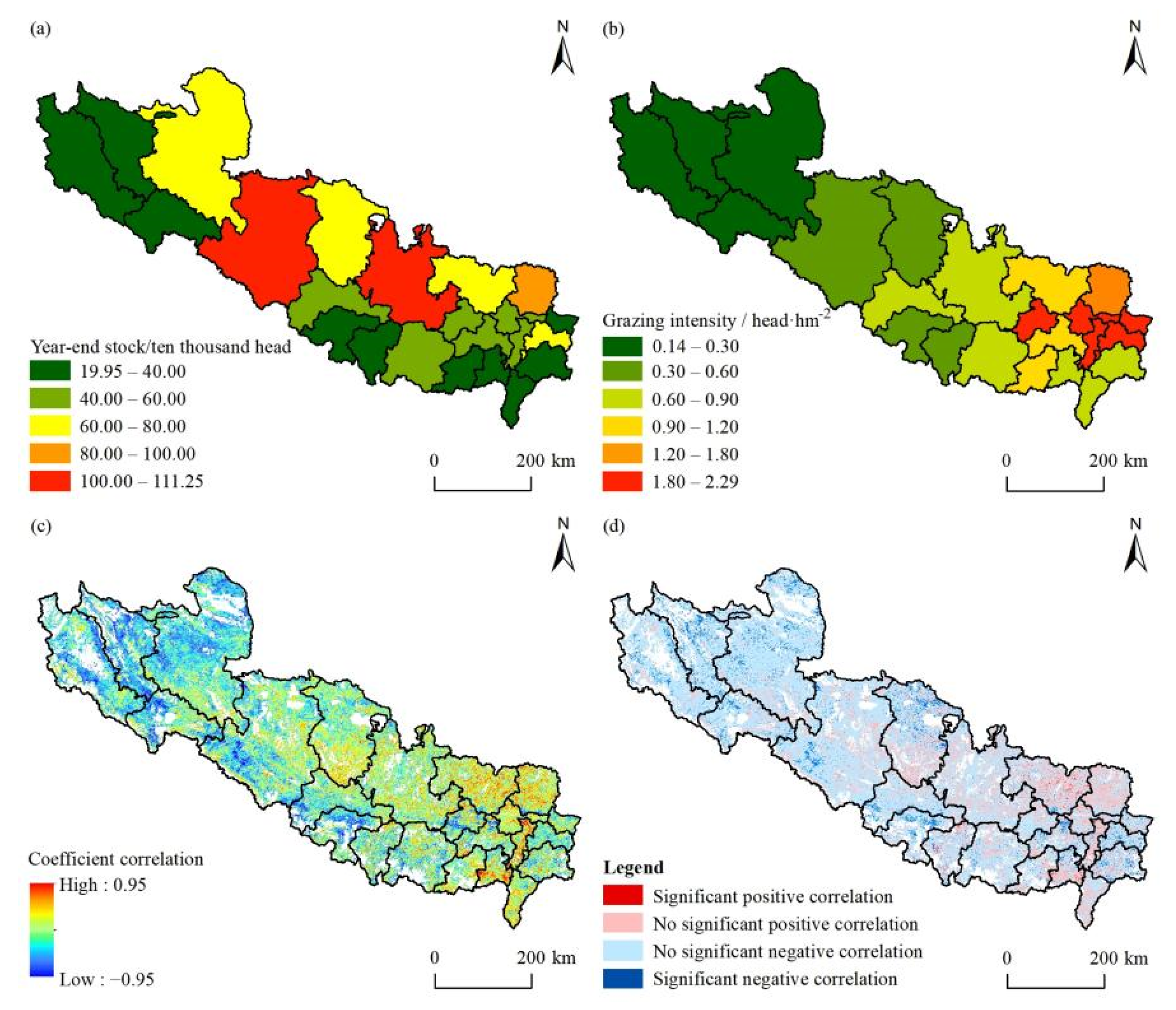
| Dataset | Time and Spatial Scale | Source of Data |
|---|---|---|
| NDVI | 2000–2020, 250 m | MOD13Q1, Google Earth Engine (https://earthengine.google.com/ (accessed on 10 December 2021)) |
| Climate dataset | 2000–2020, 1km | National Earth System Science Data Center, National Science & Technology Infrastructure of China [53] |
| Statistical data | 2000–2020 | Statistics Bureau of Rikaze and Ngari Prefecture |
Publisher’s Note: MDPI stays neutral with regard to jurisdictional claims in published maps and institutional affiliations. |
© 2022 by the authors. Licensee MDPI, Basel, Switzerland. This article is an open access article distributed under the terms and conditions of the Creative Commons Attribution (CC BY) license (https://creativecommons.org/licenses/by/4.0/).
Share and Cite
Li, Y.; Gong, J.; Zhang, Y.; Gao, B. NDVI-Based Greening of Alpine Steppe and Its Relationships with Climatic Change and Grazing Intensity in the Southwestern Tibetan Plateau. Land 2022, 11, 975. https://doi.org/10.3390/land11070975
Li Y, Gong J, Zhang Y, Gao B. NDVI-Based Greening of Alpine Steppe and Its Relationships with Climatic Change and Grazing Intensity in the Southwestern Tibetan Plateau. Land. 2022; 11(7):975. https://doi.org/10.3390/land11070975
Chicago/Turabian StyleLi, Yan, Jie Gong, Yunxia Zhang, and Bingli Gao. 2022. "NDVI-Based Greening of Alpine Steppe and Its Relationships with Climatic Change and Grazing Intensity in the Southwestern Tibetan Plateau" Land 11, no. 7: 975. https://doi.org/10.3390/land11070975
APA StyleLi, Y., Gong, J., Zhang, Y., & Gao, B. (2022). NDVI-Based Greening of Alpine Steppe and Its Relationships with Climatic Change and Grazing Intensity in the Southwestern Tibetan Plateau. Land, 11(7), 975. https://doi.org/10.3390/land11070975







